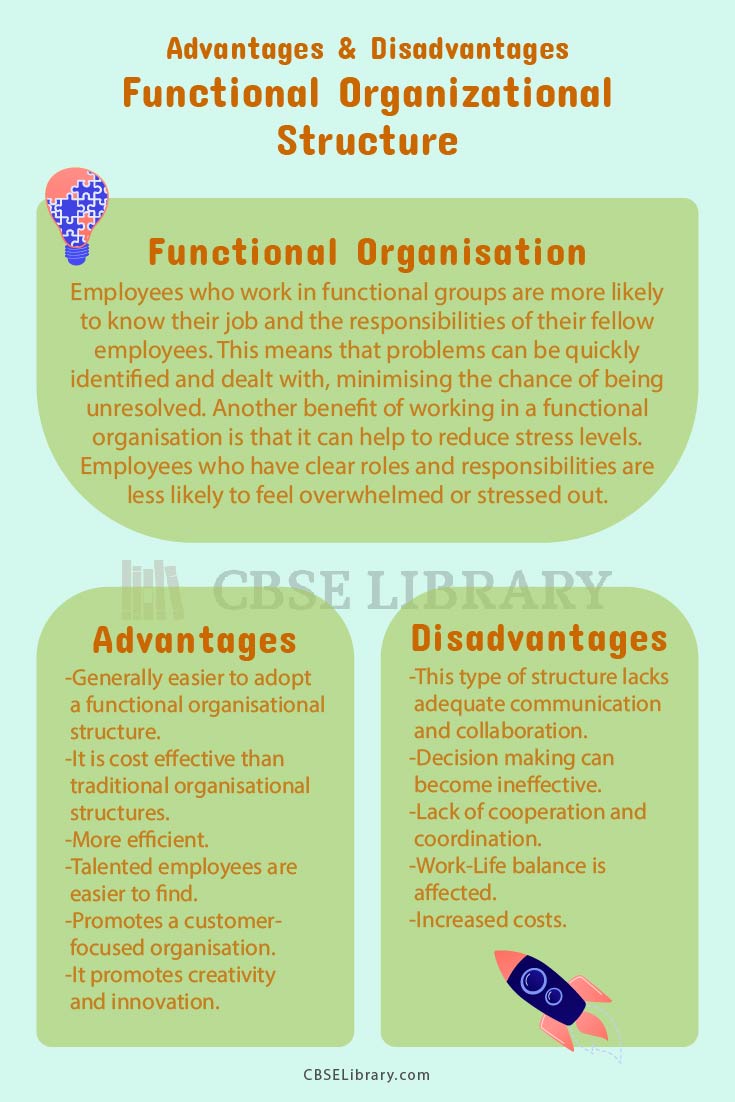Functional Organisation Advantages And Disadvantages: Functional organisations are a type of organisation where the members of the team are assigned to specific roles with a defined scope that is expressed by the company’s mission statement. In other words, a functional organisation is a type of organisation where employees are divided into functional groups, each with a specific job to do.
Students can also find more Advantages and Disadvantages articles on events, persons, sports, technology, and many more.
Functional Organisation Benefits
First, it can help improve teamwork and communication. Employees who work in functional groups are more likely to know their job and the responsibilities of their fellow employees. This means that problems can be quickly identified and dealt with, minimising the chance of being unresolved. Another benefit of working in a functional organisation is that it can help to reduce stress levels. Employees who have clear roles and responsibilities are less likely to feel overwhelmed or stressed out. They know what they need to do and where they need to be, which minimises distractions and allows them to focus on their work.
However, there are also some downsides to working in a functional organisation. First, it can be difficult for new employees to find their feet. They may not know exactly what their role is or how they fit into the overall structure of the organisation. This can make it difficult for them to feel comfortable in their position and engage with their colleagues. Overall, Functional Organisation is an effective way for businesses to organise their workforce. In this article, we shall explore their advantages and disadvantages in detail.
- Advantages of Functional Organisation
- Disadvantages of Functional Organisation
- Comparison Table for Advantages and Disadvantages of Functional Organisation
- Conclusion on Functional Organisation – Advantages And Disadvantages
- FAQs on Advantages And Disadvantages of Functional Organisation
Advantages of Functional Organisation
As discussed above, functional organisation is a way of organising work that improves the efficiency and effectiveness of an organisation. There are many advantages to using functional organisation, such as:
- Functional organisation is easier to learn and adopt: Functional organisation is a type of organisational structure that is easier to learn and use than traditional organisational structures. It is based on the principle that functions should be organised into groups that are responsible for specific tasks. This makes it easier for employees to know what they are responsible for and eliminates the need for hierarchy. Additionally, it allows employees to work together more closely as they are aware of their role in the overall process.
- It is more flexible than traditional organisational structures: Traditional organisational structures are rigid and inflexible. This makes it difficult to adapt to changing conditions, which can lead to inefficient and ineffective operations. Functional organisations, on the other hand, are more flexible and allow for a greater degree of adaptation. This makes them more effective in responding to changes in the environment and the needs of the present situation.
- It is less costly than traditional organisational structures: One of the main advantages of functional organisation is that it is less costly than traditional organisational structures. This allows organisations to expand or contract as needed. Additionally, it fosters a sense of flexibility and innovation as employees are able to work on projects that fit their skills and interests. This type of organisation also leads to a decrease in bureaucracy, which can improve efficiency and communication within an organisation.
- It is easier to communicate and collaborate: One of the many advantages of a functional organisation is that it is easier to communicate and collaborate within the organisation than within a traditional organisational structure. Communication within a functional organisation is based on shared understanding and agreed-upon goals, rather than on hierarchies and command and control structures. This allows for more efficient decision-making and quick action when needed. Collaboration within a functional organisation is also facilitated by the use of common tools and platforms, which makes sharing information between team members easy.
- It is more efficient than traditional organisational structures: An organisational structure that is based on functional lines of responsibility is more efficient than traditional organisational structures. This is because it eliminates the waste caused by duplicate work, miscommunications, and complicating factors. In a functional structure, everyone knows their job and what they’re responsible for. This cuts down on the number of meetings that are necessary to keep everyone up-to-date on what’s happening. It also leads to increased productivity because employees are more focused on their tasks.
- It is easier to find talented employees within a functional organisation: A functional organisational structure is often considered to be more efficient and effective than a traditional organisational structure. This is because it is easier to find talented employees within a functional organisation than within a traditional organisational structure. With a functional organisational structure, all departments are focused on one specific task or goal. This makes it easier for managers to identify and recruit the best talent for their organisation. Additionally, employees are more likely to feel like they are part of a team and are motivated to work together toward a common goal.
- It results in a more customer-focused organisation: A functional organisational structure enables organisations to focus on their core business and provide better customer service. This results in improved profitability and increased customer satisfaction rates. Furthermore, it allows organisations to identify and solve problems quickly, which leads to improved efficiency and productivity.
- It encourages creativity and innovation: Functional organisational structure advantages encourage creativity and innovation within an organisation. This is because it allows for different parts of the organisation to work together as a whole to create new ideas. This leads to better products and services, as well as a higher level of creativity within the organisation.
Disadvantages of Functional Organisation
While there are many advantages to having a functional organisation, there are also some disadvantages. Below are a few disadvantages of functional organisation:
- Lack of Communication and Collaboration: Functional organisations tend to lack communication and collaboration because everyone works independently. This can lead to conflicts and misunderstandings.
- Ineffective Decision Making: Because everyone works independently, decisions in a functional organisation are often slow and ineffective. This can lead to problems with the implementation of plans and projects.
- Lack of Coordination and Cooperation: Functional organisations are often difficult to coordinate and cooperate because everyone works independently. This can lead to missed opportunities and wasted resources.
- Poor Work-Life Balance: Because functional organisations tend to be structured in a way that is disadvantageous to work-life balance, employees often find it difficult to balance their work and personal lives. This can lead to burnout and stress-related illness.
- Increased Costs Due to Inefficiency and Confusion: A functional organisation can increase costs due to its inefficient structure, which leads to confusion among employees about their roles and responsibilities. This can also lead to wasted resources and lost productivity.

Comparison Table for Advantages and Disadvantages of Functional Organisation
Following are the advantages and disadvantages of Functional Organisation :
| Advantages | Disadvantages |
| Generally easier to adopt a functional organisational structure | This type of structure lacks adequate communication and collaboration |
| Functional organisational structure is much more flexible than traditional organisational structures | Decision making can become ineffective |
| It is cost effective than traditional organisational structures | Lack of cooperation and coordination |
| Functional organisational structure facilitates easier communication and collaboration | Work-Life balance is affected |
| More efficient | Increased costs |
| Talented employees are easier to find | |
| Promotes a customer-focused organisation | |
| It promotes creativity and innovation |
Conclusion on Functional Organisation – Advantages And Disadvantages
Functional organisation is a management approach that emphasises the need for effective communication and coordination between various parts of an organisation in order to create a cohesive whole. Advantages of using functional organisation include improved efficiency, better decision making, and Increased morale among employees. Disadvantages of functional organisation include increased complexity, which can make it difficult to manage, and decreased flexibility, which can lead to stagnation
FAQs on Advantages And Disadvantages of Functional Organisation
Question 1.
What is Functional Organisation?
Answer:
Functional organisation is a type of organisation where the various departments are organised according to their function. This means that the departments are responsible for carrying out specific tasks in an efficient and effective way. The staff in each department is trained to perform their duties in a specific way so that everything runs smoothly. In functional organisations, the employees are empowered to take decisions and make decisions on their own without supervision. This allows them to be creative and innovative in their work.
Question 2.
What are the advantages of Functional Organisation ?
Answer:
There are several advantages to using Functional Organisation in your business. First, it promotes a sense of cooperation and teamwork among employees. This prevents conflicts and misunderstandings, which can lead to wasted time and energy. It also ensures that all employees are working towards the same goal, making them more productive and efficient. Finally, Functional Organisation reduces the need for hierarchy – a structure that can often be dysfunctional and inefficient.
Question 3.
What are the disadvantages of Functional Organisation?
Answer:
Functional organisation is based on the idea that tasks can be divided into simple, manageable parts and that workers can be assigned to specific tasks. The disadvantages of functional organisation are that it can lead to a lack of creativity and innovation, as workers are limited in their ability to take on new challenges. It can also lead to a loss of communication and cooperation, as workers are not able to share ideas and plans with the management.
